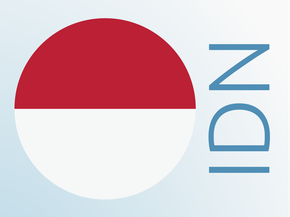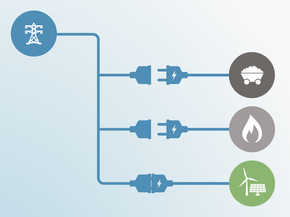Assumptions
Historical emissions
We use the historical data provided by the Second Biennial Update Report (BUR) for the period 2000-2016 and data reported to the UNFCCC in the Greenhouse gas inventory database for the period before 2000. There is a discrepancy between these two sources for the year 2000 of about 50 MtCO2e; we have made no attempt to harmonise these data sources, using the BUR data for the year 2000.
NDC and other targets
To quantify the 2030 NDC target we use the BAU and the sectoral distribution from Indonesia’s NDC document – taken at face value and without harmonisation to historical data (Republic of Indonesia, 2016).
The CAT takes the absolute emissions level excluding LULUCF by 2030 given in the official documents for the unconditional targets. Due to the lack of clarity in the conditional target, the CAT uses a range to determine the target absolute emissions level. The upper range is defined as the sum of sectoral emissions, excluding LULUCF, presented in the NDC table – which leads to a 38% emissions reduction below BAU. This has an implicit assumption that the LULUCF sector is responsible for the further emissions reductions needed to reach the 41% target. The lower range assumes that the remaining emissions reduction comes from non-LULUCF sectors, which would demand higher emissions reductions in these sectors.
The NDC does not provide an absolute emissions level for the 2020 target. To quantify the 2020 pledge, the CAT assumes the sectoral contribution to emissions reduction from Indonesia’s Second BUR, which implicitly assumes that the 2020 pledge and the NDC targets are based on the same BAU. The Second BUR shows that the LULUCF sector is responsible for around 80% of the emissions reduction in 2020.
The impact of the medium-term development plan 2020-2024 targets in total primary energy supply is quantified using a first order estimation. We assumed that the renewable power generation shares, resulting from the uptake in renewable capacity in the target, that the input in TPES increases proportionally to share in electricity production, and that replacing fossil electricity reduces TPES by a factor one to two. Approximately 1kWh from renewables instead of 1kWh coal (produced with efficiency 1 to 3) reduces TPES by (-3+1) kWh.
Current policy projections
We construct the range of current policy projections based on different assumptions of what might happen to the coal-heavy power sector in Indonesia in the future. The scenarios are based on the reference “Business-as-usual” scenario from the Asia Pacific Energy Research Centre (APERC), which "assumes current policies and trends continue" (APERC, 2019), and on Indonesia’s 10-year electricity supply plan RUPTL 2019-2028 (Republic of Indonesia, 2019b). According to APERC, the share of coal in power generation will decrease from 56% in 2016 to 55% in 2020, 50% in 2025 and then increase again to 51% in 2030. The APERC scenario is developed by an independent organisation and is used as an alternative development pathway since it is based on its own GDP and energy demand projections. The implementation of the RUPTL leads to coal shares of 66% in 2020, 55% in 2025 and 54% in 2028. Using emission factors from the IEA’s Current Policies Scenario for non-OECD Asia, multiplied by the coal, oil, and gas shares for both TPES and electricity related emissions according to the APERC BAU scenario, gives the upper bound of emissions in our Current Policy Scenario for the energy sector, representing continued use of coal. Note that the APERC BAU scenario is consistent with increasing installed capacity of coal by 5 GW between 2016 and 2025, in comparison to 22 GW under the RUPTL 2019-2028.
The total electricity demand forecast by the RUPTL is higher than that in the APERC reference scenario, however the projected electricity generation has substantially decreased in comparison to previous years. It is to be noted that in our current policy scenario, the target of 23% renewables in TPES is not reached.
We subsequently add non-energy and non-CO2 emission projections from the Second BUR and harmonise the resulting time series with energy-CO2 projections. The emissions levels are sensitive to the method of harmonisation. Thus, we apply two methods:
- Apply growth rates of the calculated scenarios to the last historical year;
- Adjust all future years by the difference of the calculated scenario and the inventory in the last available year (2016).
Both methods are included in the range presented for current policy projections.
Planned policy projections
Our planned policy scenario assumes that Indonesia will achieve renewable energy targets in both NEP and RPJMN 2020-2024. The trajectory reaching the NEP targets is constructed using APERC projections of total supply and demand as a baseline and adapting the relevant shares of renewables. It is assumed that the share of renewables in TPES will develop linearly from 2025 and 2050 between the targets for those years. The lower range, based on the RPJMN renewable installed capacity target, is created adjusting installed capacities and electricity generation from the RUPTL 2019. We assume two scenarios for renewable deployment under different mixes: one that assumes more intermittent renewables (lower capacity factor) and another with more hydro and geothermal projects. The resulting emissions reductions are subtracted from the current policy scenario.
This scenario is shown additionally to the range of current policy scenarios and the pledges based on the NDC’s BAU. Despite the continuing importance of coal in this scenario, it does result in substantially lower emissions than the current policy scenario range and would lead to Indonesia overachieving its conditional 2030 NDC target.
COVID-19 impact
We applied a novel method to estimate the COVID-19 related dip in greenhouse gas emissions in 2020 and the deployment through to 2030. The uncertainty surrounding the severity and length of the pandemic creates a new level of uncertainty for current and future greenhouse gas emissions. We distil the emission intensity (GHG emissions/GDP) from the pre-pandemic scenario, last update in December 2019), and apply it to most recent GDP projections that take into account the effect of the pandemic. We have used a range of estimates to estimate the potential impact of the pandemic on GDP, including national projections by the Bank of Indonesia (ADB, 2020; Brown, 2020; IMF, 2020; OECD, 2020; World Bank, 2020). The national and international estimates only cover 2020 and 2021. We used the growth rates from our pre-COVID-19 current policy scenario to extend those projections to 2030.
Global Warming Potential values
The CAT uses Global Warming Potential (GWP) values from the IPCC’s Fourth Assessment Report (AR4) for all its figures and time series. Assessments completed prior to December 2018 (COP24) used GWP values from the Second Assessment Report (SAR).
Further analysis
Country-related publications
Stay informed
Subscribe to our newsletter






